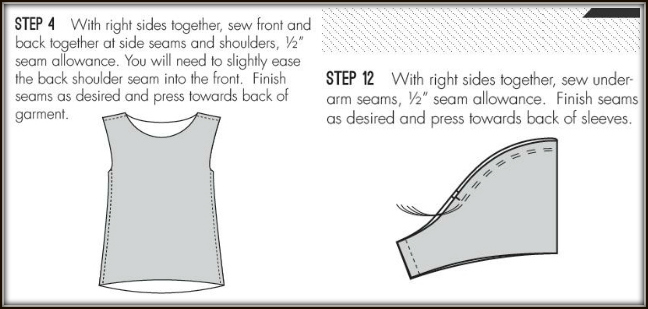Are you a round or flat person? Um, lemme rephrase that. When given the choice, do you like to construct your garments using an in-the-round method or in-the-flat method?
Nettie bodysuit sleeve attached flat
I don't know what else to call these techniques, really, so if you have no idea what I'm yapping about, here's the basic idea. On a bodice or top, most patterns have you sew the shoulder seams, side seams, and underarm sleeve seams pretty early on in the construction process. This creates round openings for the armholes, neck finishings, bottom opening (t-shirt hem/bodice opening to attach to skirt/etc), and sleeve caps. Here's the Scout Tee pattern as an example:
An alternative method is to leave those seams open so you can construct everything flat instead of in the round. For example, sew only one shoulder seam, attach the neck binding, then sew the other shoulder seam. You can also attach your sleeves and finish your hems BEFORE sewing the side seams and underarm seams. Here's an example from the Plantain Tee pattern for attaching sleeves flat:
I'm pretty fascinated with industrial techniques for making garments. When I "shop," I just turn clothes inside out to inspect the finishing techniques and make Hmmm noises. Of course, the fashion industry's primary goal is making clothing as quickly and cost-efficiently as possible, which means that the way they do things isn't necessarily the best way a home sewer should do them, or the way we even can with our measly little junk machines ;) However, I do strive to find ways to make sewing easier for me, and I will always try alternative methods if I think they will be faster but still achieve the same, or very similar, results.
Storebought tank with straps attached flat before side seams are sewn
Sewing garments flat is one of those industrial methods that I will almost always turn to if possible. Awhile ago, Colette Patterns' blog featured a guest post from Sharon Blair explaining different industry practices. One of them was as follows:
"Perform similar operations at the same time and sew flat. Sew the details first. Set these aside. Then start assembling the garment. Complete as much as you can before joining side seams. Sewing in a tube is more time consuming than sewing flat."
It's true that if you inspect your store-bought garments, you can tell that the side seams are usually sewn last in one continuous line of stitching from the sleeve opening to the hem. Many of my t-shirts have one shoulder seam sewn after the neckband is attached, and even sleeves that were hemmed before the underarm seam was sewn. To keep the serged seam more obscure, it's always pressed and tacked down toward the back of the garment. Would you ever know the differences here if you weren't looking for them?
Storebought t-shirt with sleeves hemmed before side seams sewn
I often change construction so I can use these methods, too. I never ever set in sleeves, no matter the fabric type or sleeve cap size-- I attach them flat because it's easier to ease the sleeve cap evenly this way. I'll do the same for armhole bindings because it's easier to sew on binding around curves when those curves are not yet attached in a circle. On t-shirt nec kbands, I will leave one shoulder open so I don't have to do any measuring; I'll just cut a long binding piece and "feel the stretch" as I pin it on, then snip off the excess once I reach the other shoulder. For super small hem openings, like the legs of baby leggings, hemming the legs flat is faster than forcing your presser foot around a tiny tube, especially on a coverstitch machine like mine that likes to stall and skip stitches when sewing over seams.
I figured everyone else would be lazy like me and prefer the flat construction method. However, when I was pattern-testing the Nettie Bodysuit, I applauded Heather for including instructions for constructing the neckband flat (shown above). She followed up with me to say that other testers didn't like that method, so she changed it back to "in the round" instructions for the published version. Y'all are just some tidy little seamsters, aren'tcha.
So that made me wonder why someone would choose the round over the flat method. Does the end result look cleaner? Do you find that the methods are actually comparable in how easy or fast they seem? Do you use one on certain fabric types only? Or you just prefer to follow the pattern instructions regardless? What's your choice?






